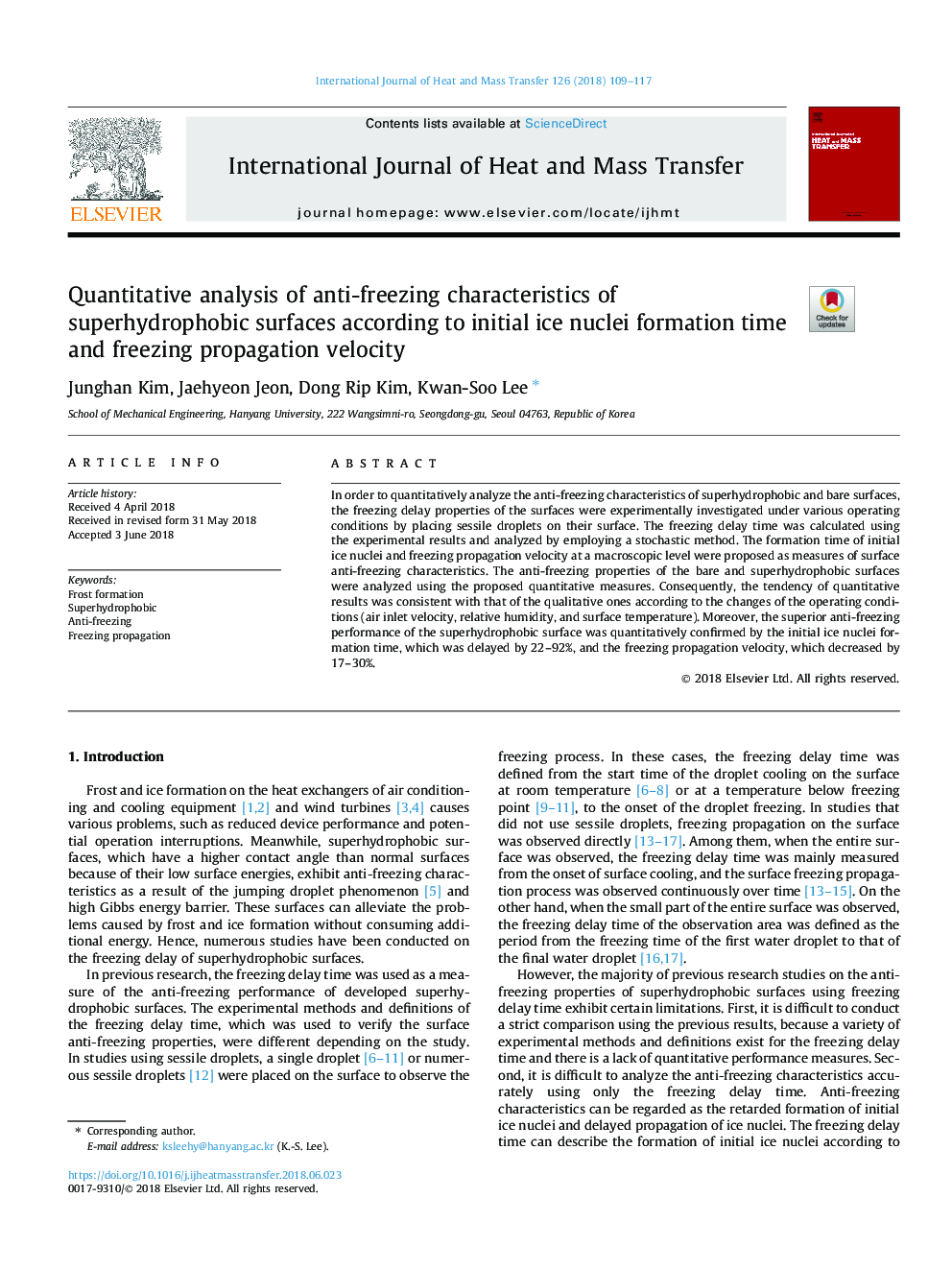| کد مقاله | کد نشریه | سال انتشار | مقاله انگلیسی | نسخه تمام متن |
|---|---|---|---|---|
| 7053858 | 1458013 | 2018 | 9 صفحه PDF | دانلود رایگان |
عنوان انگلیسی مقاله ISI
Quantitative analysis of anti-freezing characteristics of superhydrophobic surfaces according to initial ice nuclei formation time and freezing propagation velocity
ترجمه فارسی عنوان
تجزیه و تحلیل کمی از ویژگی های ضد انجماد سطوح سوپر هیدروفوفی با توجه به زمان تشکیل اولیه یخ و سرعت انتشار انجماد
دانلود مقاله + سفارش ترجمه
دانلود مقاله ISI انگلیسی
رایگان برای ایرانیان
کلمات کلیدی
شکل گیری یخبندان، سوپر هیدروفوبیک، ضد انجماد، انتشار انجماد،
ترجمه چکیده
به منظور تجزیه و تحلیل کمی ویژگی های ضد انجماد سطوح فوق العاده هیدروفاژ و لخت، ویژگی های تاخیر انجماد سطوح در شرایط مختلف عملیاتی با قرار دادن قطرات سفت در سطح آنها مورد بررسی قرار گرفت. زمان تاخیر انجماد با استفاده از نتایج تجربی محاسبه و با استفاده از یک روش تصادفی مورد تجزیه و تحلیل قرار گرفت. زمان تشکیل هسته ی یخ اولیه و سرعت انتشار انجماد در یک سطح ماکروسکوپی به عنوان شاخص های ضد انجماد سطحی پیشنهاد شده است. خواص ضد انجماد سطوح لاغر و سوپر هیدروفوفی با استفاده از معیارهای کمی پیشنهاد شده مورد تجزیه و تحلیل قرار گرفت. درنتیجه، گرایش نتایج کمی با توجه به شرایط کیفی مطابقت دارد با تغییرات شرایط عملیاتی (سرعت ورود هوا، رطوبت نسبی و دمای سطح). علاوه بر این، عملکرد ضد انجماد برتر سطح فوق العاده هیدروفوفیک به طور کمی با زمان تشکیل اولیه یخ، تایید شده با تأخیر 22-92٪ و سرعت انتشار انجماد، که به میزان 17-30٪ کاهش یافت، به طور کمی تایید شد.
موضوعات مرتبط
مهندسی و علوم پایه
مهندسی شیمی
جریان سیال و فرایندهای انتقال
چکیده انگلیسی
In order to quantitatively analyze the anti-freezing characteristics of superhydrophobic and bare surfaces, the freezing delay properties of the surfaces were experimentally investigated under various operating conditions by placing sessile droplets on their surface. The freezing delay time was calculated using the experimental results and analyzed by employing a stochastic method. The formation time of initial ice nuclei and freezing propagation velocity at a macroscopic level were proposed as measures of surface anti-freezing characteristics. The anti-freezing properties of the bare and superhydrophobic surfaces were analyzed using the proposed quantitative measures. Consequently, the tendency of quantitative results was consistent with that of the qualitative ones according to the changes of the operating conditions (air inlet velocity, relative humidity, and surface temperature). Moreover, the superior anti-freezing performance of the superhydrophobic surface was quantitatively confirmed by the initial ice nuclei formation time, which was delayed by 22-92%, and the freezing propagation velocity, which decreased by 17-30%.
ناشر
Database: Elsevier - ScienceDirect (ساینس دایرکت)
Journal: International Journal of Heat and Mass Transfer - Volume 126, Part B, November 2018, Pages 109-117
Journal: International Journal of Heat and Mass Transfer - Volume 126, Part B, November 2018, Pages 109-117
نویسندگان
Junghan Kim, Jaehyeon Jeon, Dong Rip Kim, Kwan-Soo Lee,
